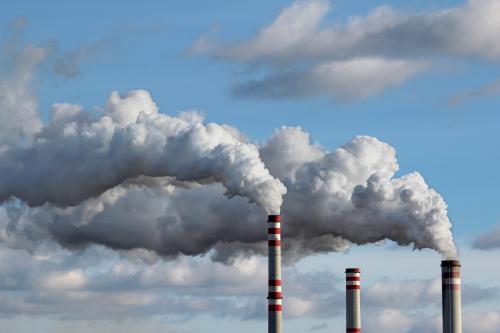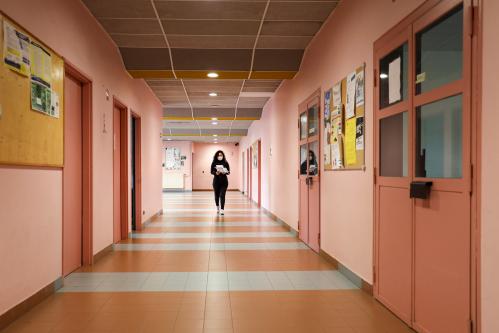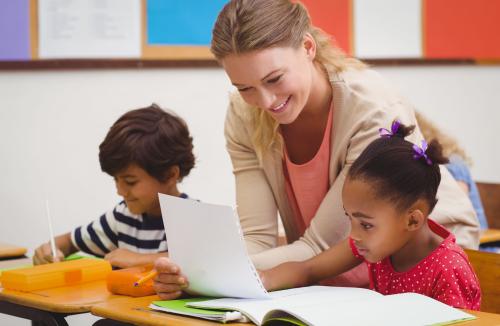COVID-19 has changed the way we understand school building ventilation and its importance in keeping us safe from viruses and bacteria in the air. The pandemic has motivated many school leaders to invest in improvements to ventilation systems, but the benefits of investing in a safe learning environment extend far beyond protecting children from the coronavirus. The evidence I present below suggests that pollution exposure is not only a factor in student academic outcomes but also a major driver of inequality in outcomes between wealthier and lower-income children, and between white and nonwhite children.
Why is it so important to invest in school infrastructure now? There is evidence that school ventilation protects children from contracting COVID-19 and other viruses in schools. Research suggests that COVID-19 spreads in schools in situations where there are high case rates in the surrounding community, and children can still catch COVID-19 in school buildings that are not properly ventilated.
I recently released a study (with Kathryn Johnson) showing that higher air pollution can make people more likely to get sick with and die from COVID-19. Because air pollution harms the immune system, it can increase the likelihood of infection from airborne diseases. It also can lead existing cases of COVID-19 to become more severe by harming the immune systems of infected people. We used the variation in pollution caused by a rollback of environmental enforcement during the pandemic to estimate the effects of increased pollution on county-level COVID-19 deaths and cases. We find that counties with more Toxic Release Inventory (TRI) sites (local factories or federal plants that emit harmful classes of pollution) saw an 11.8% increase in air pollution on average following the Environmental Protection Agency’s (EPA’s) rollback of enforcement, compared to counties with fewer TRI sites. We also find that these policy-induced increases in air pollution are associated with a 53% increase in cases and a 10.6% increase in deaths from COVID-19.
Beyond COVID-19
In addition to providing some protection against illness, there is evidence that air filters, like those commonly used in modern HVAC systems, can limit children’s exposure to local air pollution. There is mounting evidence that air pollution can harm children’s development and academic outcomes. In another new paper, I (along with Joanna Venator) use detailed Florida public school data to assess how children’s outcomes change when a TRI site opens or closes within a mile of their school. The comparison group is composed of students attending schools between one and two miles away from a TRI site at the same time in the same zip code. We find that exposure to pollutants in schools has significant, negative impacts on test scores and being suspended or absent from school.
Note that the conditions we’re exploring in this study are not unique to Florida. There are currently about 21,800 TRI sites operating across the United States, and the EPA estimates that 59 million people (on average, about 19% of the population living in every state) live within one mile of a TRI site. Nearly 22% of all public schools were within one mile of a TRI facility in 2016, and these sites exist in both urban and rural areas.
In addition, over 6.4 million U.S. children attend public school within 250 meters of a major roadway. In another paper, I (along with David Simon and Jenni Heissel) compare students who have to switch from elementary to middle school or from middle school to high school as they progress through the school system. We compare children who switch from a school that is upwind from a highway to a school that is downwind of a highway, and find that highway air pollution negatively affects students’ test scores, behavior, and absences.
We also know that air quality affects children’s performance on the day of the test. Because pollution might make children more disruptive, another recent study finds that exposure to pollution has spillover effects onto children who are not themselves exposed to pollution. Thus, pollution can affect schoolchildren’s outcomes both directly and indirectly.
Uneven exposure to pollutants reinforces social inequalities
The pandemic has also brought into sharp relief the consequences of social disparities, which is a common theme in the literature exploring environmental conditions and student outcomes. For example, children who attend school near a major highway are more likely to be low income or nonwhite than children attending school elsewhere. Low-income, Black and Latino children are also more likely to live near Superfund sites (the worst federal toxic waste sites) and to attend school near TRI sites. It is evident, therefore, how uneven exposure to pollutants along socioeconomic lines contributes to long-standing achievement gaps.
These socioeconomic differences extend to the quality of school facilities as well. According to the Government Accountability Office’s national survey of school districts, about 54% of public school districts need to update or replace multiple building systems or features in their schools, with heating, ventilation, or air conditioning being the most common system in need of attention. They also find that capital construction expenditures were on average $300 less per student in high-poverty districts ($719 per student) compared to low-poverty districts ($1,016 per student). This funding disparity reflects fewer resources to spend in spite of the greater needs, in most cases, of lower-income districts. Whereas wealthier districts can make up funding shortfalls from the state through raising local taxes, high-poverty districts are more likely to rely on state funding and have difficulty making up the difference in lean years.
Investments in School Infrastructure Can Mitigate Harm
How much might HVAC system upgrades in schools help? In a recent study, Gilraine finds that putting air purifiers in classrooms led to a 0.2 standard deviation increase in test scores for children, compared to children in local schools that did not get the air purifiers. (See here for Gilraine’s summary on Brookings’s Brown Center Chalkboard.) This is similar to the effect of small class sizes in the famed Tennessee STAR experiment. This suggests that air filtration, like that offered by modern HVAC systems, could improve children’s academic and behavioral outcomes long after the COVID-19 pandemic has concluded. Low-income children stand to be impacted the most by improvements in air quality; there is evidence that their school buildings are in worse shape in many places and that they are more likely to live near sources of pollution.
Right now there is a debate over whether schools should be part of President Biden’s infrastructure bill. Some are concerned that spending on schools could be wasteful or unnecessary. However, the evidence suggests that upgrading school buildings would be both a timely and wise investment that is likely to pay dividends for years to come.





![An air conditioning unit, top left, was added to this sixth-grade class room upgrade at Sherwood Middle School in Columbus on September 5, 2019, as part of Operation: Fix It, the five-year, 125-million plan funded by a 2016 bond issue to repair Columbus City Schools facilities. [Kyle Robertson/Dispatch]](https://www.brookings.edu/wp-content/uploads/2022/01/2021-08-25T154105Z_597664506_MT1USATODAY16623492_RTRMADP_3_AN-AIR-CONDITIONING-UNIT-TOP-LEFT-WAS-ADDED-TO-THIS.jpg?quality=75&w=500)

Commentary
Now is the time to invest in school infrastructure
May 19, 2021